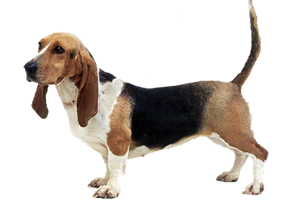Basset Artésien Normand
Norman Artesian Basset

The Basset Artésien Normand is a scenthound that originated in France. It was developed to hunt small prey such as rabbits either alone or in packs, with the hunter on foot.
Although the popular Basset Hound was created in England, there are actually six recognized breeds of basset, the other five are from France. They Include the Basset Artésien Normand and its “cousins” the Basset Bleu de Gascogne, Basset Fauve de Bretagne, Grand Basset Griffon Vendéen, and Petit Basset Griffon Vendéen.
While the Basset Artésien Normand is little known outside its homeland, it is the most popular basset in France.
Basset Artésien Normand Standards
- 10-14"
- 32-34 lbs
- low to the ground, short scenthound
- long, hanging ears
- tail is long and tapers at end
- short coat requires little care
- fawn and white
- tricolor
History of the Basset Artésien Normand
Bassets have been known throughout France for centuries, with written records dating back to 1585. It is unknown how this type of dog was created, some have suggested they descend from other short-legged breeds such as Dachshunds or Corgis. Other experts believe that dwarfed scenthounds (possibly from the Saint Hubert Hound) were the first bassets. The latter is the more preferred theory, however, their origin is further debated as to whether or not this occurred multiple times or if different breeds were simply crossed with existing bassets.
However they came into existence, eventually, nearly every type of French hound had a basset variety. It is believed that some of the oldest of these breeds are the Basset Bleu de Gascogne and the now extinct Basset Saintongeois.
By the 1600s both the extinct Normand Hound and Chien d’Artois had basset varieties. The Basset d’Artois was known to have straight front legs and the Basset Normand’s were crooked. In these early stages, these dogs had many coat colors and had both a smooth (known then as the Basset Francais) and wire-coated (Basset Griffon) varieties. Much like the Basset Vendéens they also had two different lengths of leg as well.
In the early 1900s local breeders chose to combine the Basset d’Artois and Basset Normand into one breed, the Basset Artésien Normand. By then only the short coated variety (with the shorter legs) existed. Today, this breed can still be found in packs working in France but is also popular there as a companion animal.
Related Breeds:
